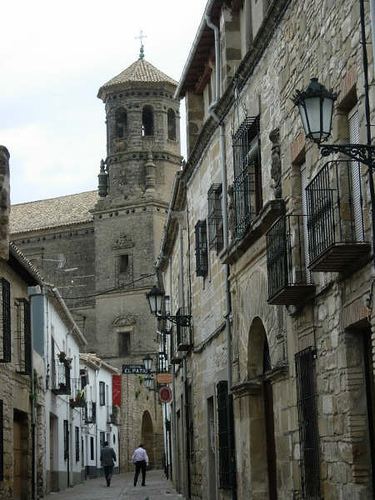Country Spain Comarca La Loma Demonym(s) Baezanos Elevation 769 m Province Province of Jaén | Autonomous community Andalusia Judicial district Baeza Time zone CET (UTC+1) Area 194.3 km² Local time Tuesday 9:05 AM | |
 | ||
Weather 7°C, Wind SW at 6 km/h, 82% Humidity Points of interest Palacio de Jabalquinto, Plaza del Pópulo, Church of Santa Cruz, Museo de la Cultura del Olivo, Laguna Grande | ||
Baeza a world heritage site
Baeza ([ba.ˈe.θa]), formerly also written as Baéza, is an Andalusian town in the province of Jaén in southern Spain. It lies perched on a cliff in the Loma de Úbeda, the range separating the Guadalquivir River to its south from the Guadalimar to its north. It is now principally famed for having some of the best-preserved examples of Italian Renaissance architecture in Spain. Along with Úbeda, it was added to UNESCO's list of World Heritage Sites in 2003.
Contents
- Baeza a world heritage site
- Map of Baeza JaC3A9n Spain
- Baeza ubeda spain
- History
- Landmarks
- Transportation
- Notable residents
- International relations
- References
Map of Baeza, Ja%C3%A9n, Spain
Baeza ubeda spain
History
The town stands at a high elevation about 3 miles (4.8 km) from the right bank of the Guadalquivir in the Loma de Úbeda. Under the Romans, the town was known as Beatia. Following its conquest by the Visigoths, Beatia was the seat of a bishop between AD 656 and 675. This diocese had earlier been located at Castulo and appropriated territory formerly held by Tucci. The diocese was suppressed in 900.
Baeza reached its greatest prosperity under Islamic rule, when it formed the capital of an effectively independent kingdom and reached a population of around 50,000. Remnants of the Moors' fortifications include the town's Jaén and Úbeda gates and the Arch of Baeza. The Christian diocese was reëstablished in 1127 or 1147 following the town's conquest by Alfonso VII of Castile, but it was then reconquered by the Muslims and its cathedral adopted as a mosque. The town never recovered from the destruction endured upon its conquest by Ferdinand III of Castile in 1227 or 1239. The diocese of Baeza was merged with Jaén in 1248 or 1249, but continues to function as a titular see of the Roman Catholic Church.
The red dye made from a local cochineal came to be celebrated and a second era of lesser prosperity occurred in the 16th century, when Baeza and nearby Úbeda grew rich from their textile industry. Local nobles hired major architects of the era (including Andrés de Vandelvira) to design the present cathedral, churches, public buildings, and private palaces in the then-fashionable Italian style. The town's university building dates to 1533. The economy collapsed in the 17th century, with the only remaining industry consisting of local production of grain and olive oil. As few newer structures were built during this period, this had the effect of preserving the town's Renaissance legacy. The university closed for a time before being reopened by the 19th century as a seminary. In the 1870s, the population was around 11,000; over the next few decades, the Linares–Almeria railway was constructed nearby and town's population grew to 14,000 by 1900.
Landmarks
Baeza still houses its cathedral and several fine public buildings:
Transportation
Baeza is 327 km (203 mi) south of Madrid by highway. The Linares–Baeza RENFE railway station is 15 km (9 mi) away to the southwest; it lies on the Linares-Almeria line. There are bus connections to Granada, Málaga, and Madrid. Granada (132 km or 82 mi) and Málaga (241 km or 150 mi) are the nearest international airports.
Notable residents
The titular diocese has had the following incumbents:
International relations
Baeza is twinned with:
